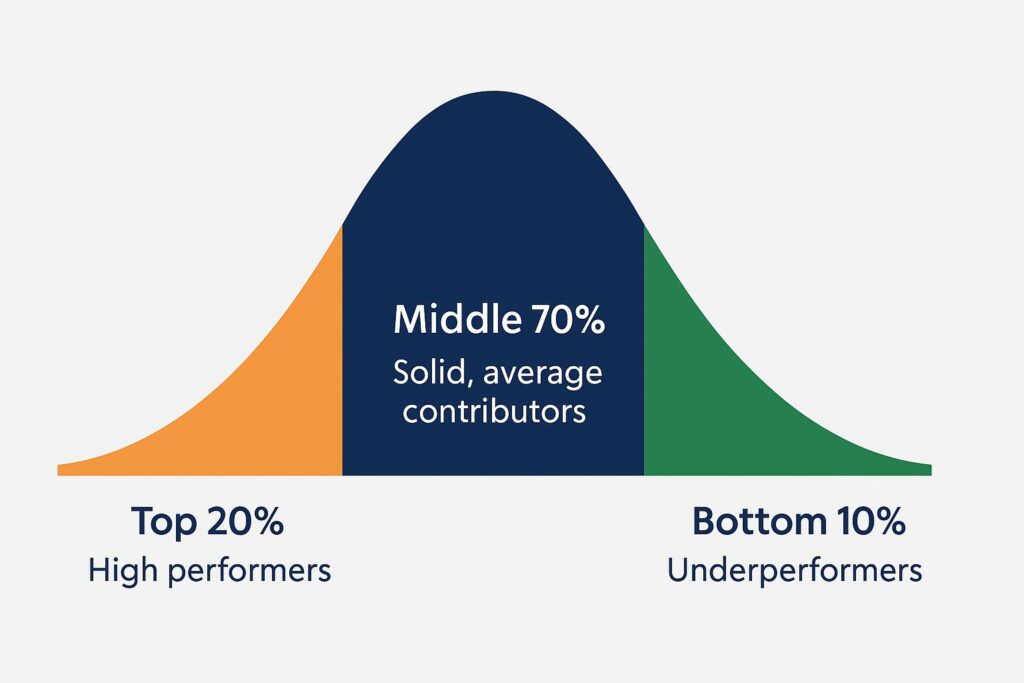Why I Don’t Recommend Forced Ranking in Performance Appraisal Systems
July 31st, 2025 – 5 minute read.
Contents
The Need to Measure Performance
What Is Forced Distribution (In Performance Appraisals)
The Arguments For Forced Distribution
The Downsides of Forced Distribution Appraisal Systems
What Good Appraisal Systems Look Like
The Need to Measure Performance
Performance appraisal systems are a constant feature in conversations I have with senior leaders during my training programmes or one-to-one mentoring.
Whether we’re discussing quarterly check-ins, annual reviews, or broader talent strategies, the question of how to assess performance fairly and effectively always crops up.
And without fail, someone mentions forced distribution, also known as forced ranking or stack-ranking.
It’s a model that was popularised by the late Jack Welch at General Electric and has since been adopted, adapted, and, in many cases, quietly abandoned by companies around the world.
However, despite its controversial track record, it still appears in boardrooms as a potential solution to a very real problem: distinguishing between high, average, and low performers.
On paper, it sounds compelling. But in practice, it often causes more harm than good.
What Is Forced Distribution?
Forced distribution is a performance appraisal system where managers must allocate a fixed percentage of their team into predetermined categories.
For example:
Top 20% – High performers
Middle 70% – Solid, average contributors
Bottom 10% – Underperformers

The intent is to eliminate inflated ratings, identify top talent, and drive out poor performers.
However, this structure overlooks a crucial fact: not every team follows a neat bell curve. Sometimes, your whole team genuinely is performing well; other times, more than 10% might be struggling.
By applying a fixed formula to something as complex and human as performance, we risk distorting reality and damaging the very people we’re trying to develop.
The Arguments For Forced Ranking Appraisal Systems
Let’s be fair. There are reasons why this approach gained popularity.
#1. It forces clarity and differentiation.
Performance appraisal systems often suffer from “everyone’s doing great” syndrome. Forced ranking cuts through that, helping leaders separate genuine high performers from the pack.
#2. It supports strategic decisions.
When applied thoughtfully, it can help with succession planning, pay decisions, and talent reviews. It gives senior leaders a bird’s-eye view of where to invest development effort.
#3. It minimises manager bias.
Without constraints, some managers rate their whole team as “above average” to avoid difficult conversations. A distribution model forces a degree of objectivity, at least in theory.
#4. It can drive accountability.
Jack Welch famously used forced ranking to create what he called a “high-performance culture” at GE, managing out the bottom 10% of performers annually.
But while these arguments are all compelling in principle, they rarely hold up in practice.
The Downsides of Forced Distribution Appraisal Systems
#1. It kills morale and motivation.
I can recall conversations where managers have told me about having to rate someone as ‘low’ purely because someone had to be in this quota.
The result? Frustration, disengagement, and in many cases, attrition. A University of Pennsylvania study found that morale takes a serious hit when employees are ranked against one another, especially in high-performing teams.
#2. It creates toxic competition.
When people know they’re being compared directly to their peers, collaboration suffers.
Instead of sharing ideas or helping colleagues, employees start holding back to protect their own standing. Microsoft abandoned forced ranking in 2013 for exactly this reason, it was eroding teamwork and fuelling internal rivalry.
#3. It imposes false constraints on talent.
If your whole team is exceeding expectations, why should you be forced to call 10% of them underperformers?
This not only misrepresents reality but also undermines your credibility as a leader.
#4. It introduces legal and inclusion risks.
Several high-profile organisations such as Goodyear and Ford Motor Co have faced lawsuits over forced ranking systems, particularly when protected groups appear disproportionately in the lowest categories.
If your appraisal system disproportionately affects older workers or people from minority backgrounds, you’re opening the door to serious legal consequences.
#5. It’s falling out of favour.
Major organisations like Adobe, Accenture, and Deloitte have all scrapped forced distribution models in recent years.
Adobe, for example, reported a 30% reduction in voluntary turnover after switching to real-time feedback and regular check-ins instead.
What Good Performance Appraisal Systems Look Like
Modern performance appraisal systems must reflect the dynamic, collaborative nature of today’s workplaces.
People don’t work in silos anymore, and if they do, that’s rarely what we want.
We solve problems together, learn on the fly, and adapt constantly.
This means we need a system that:
- Encourages regular, honest feedback throughout the year.
- Enables meaningful performance conversations, not just ratings.
- Recognises context and individual contribution.
- Supports development as much as it evaluates results.
And above all, leaders need to feel confident making fair, evidence-based judgements about performance, without relying on artificial constraints or formulas.
To achieve this, they must have confidence in the system and believe it is fair, as they will be the ones responsible for justifying their decisions to the people they lead.
The Key Questions to Ask
If you’re still using a forced ranking model, or considering introducing one, I urge you to pause.
Ask yourself:
- What kind of culture are we trying to create?
- Does stack-ranking align with, or contradict, the organisational values that are proudly displayed on your company website?
- Is this system helping you bring out the best in your people? Or is it just a way to avoid difficult conversations?
Performance appraisal systems should drive improvement, not resentment.
They should support managers in developing their people, not pit colleagues against each other.
And above all, they should reflect the real dynamics of your business and your team.
Your coach,

Found this useful? Each week, I send out The Leader’s Kit Bag – a short, practical email with one idea and one tool to help you take one step forward as a leader.
You can get the next one here.
Two things you can do to say thank you for this free resource
Subscribe to ”The Ben Morton Leadership Podcast“ on your preferred podcast platform to help us grow the show and bring you more fantastic interviews with senior leader
Connect with me on LinkedIn for regular leadership tips and insights. Be sure to add a personal note with the request.
Connect with Ben